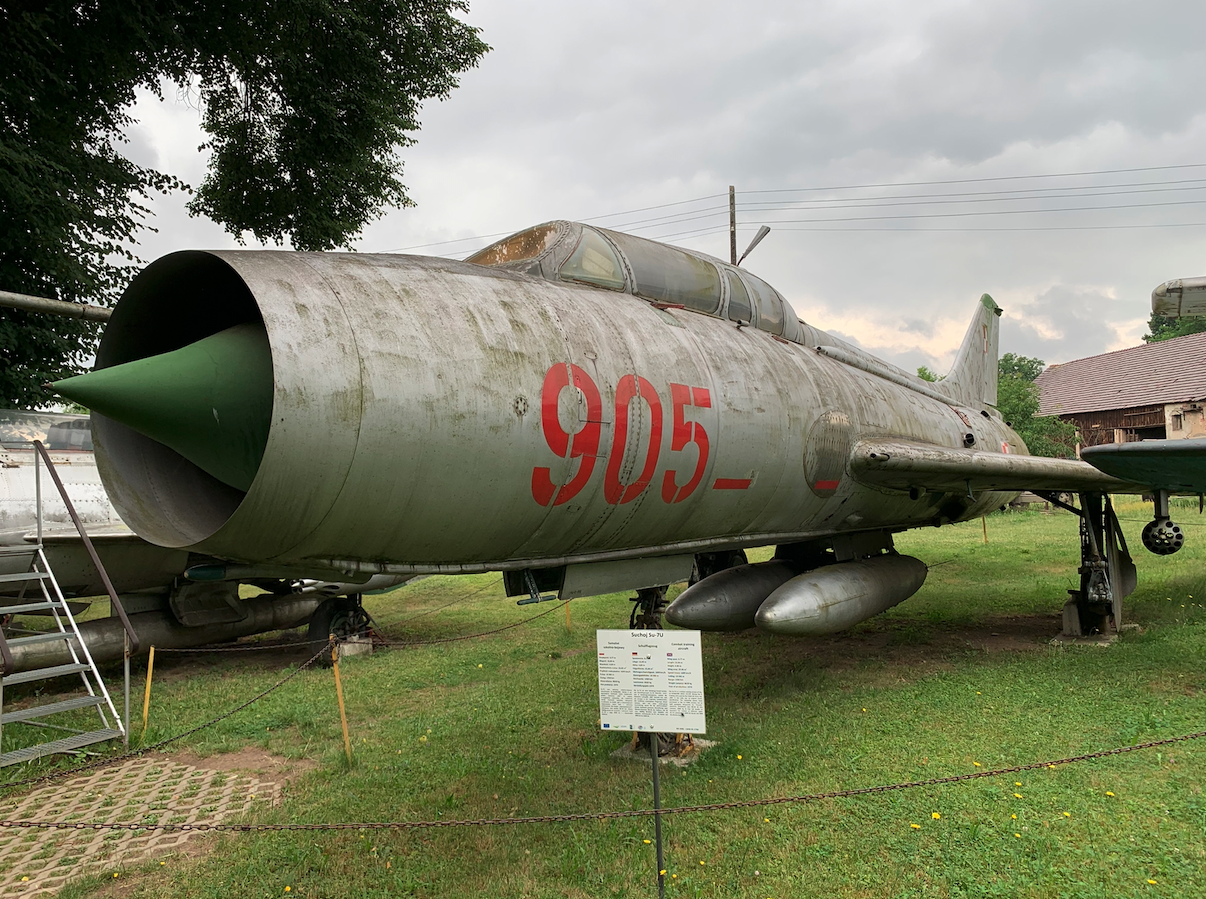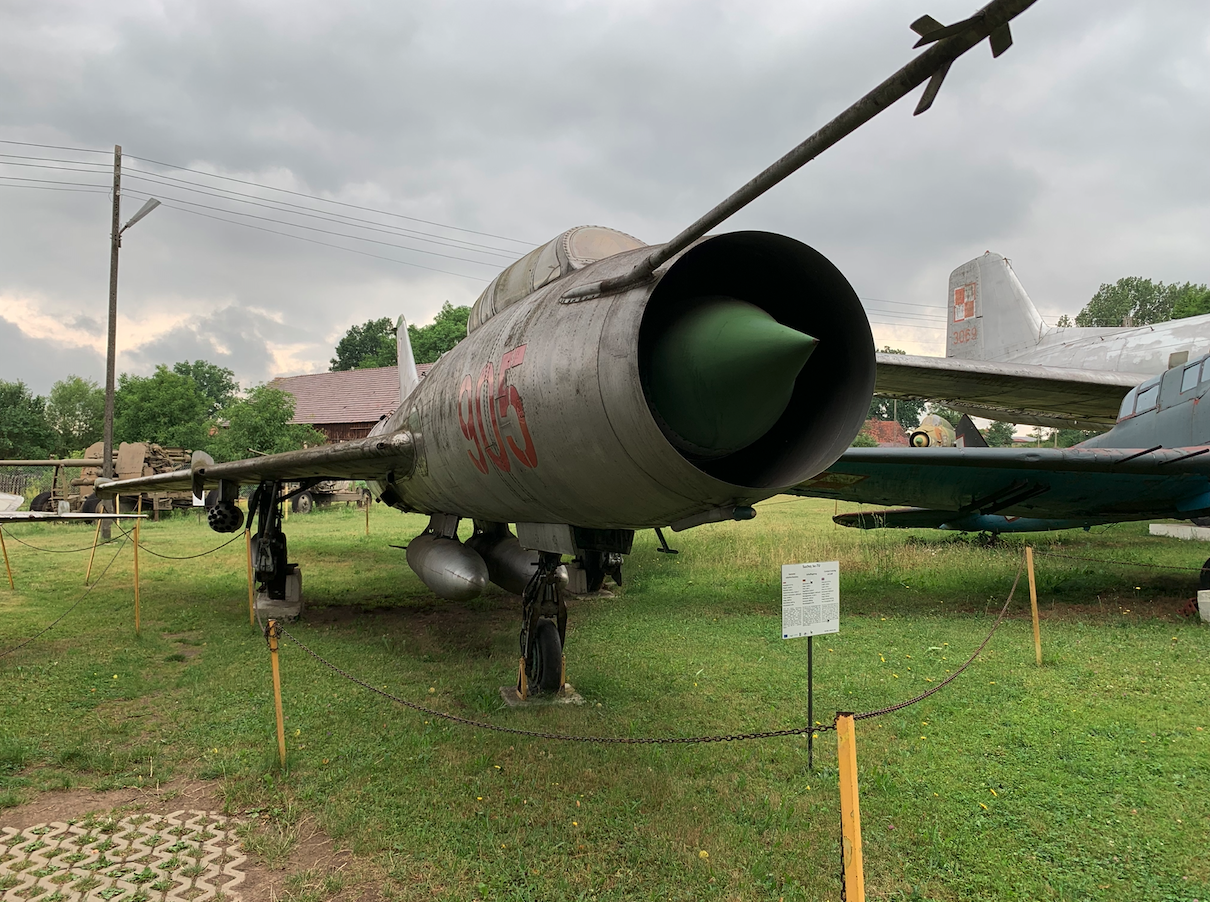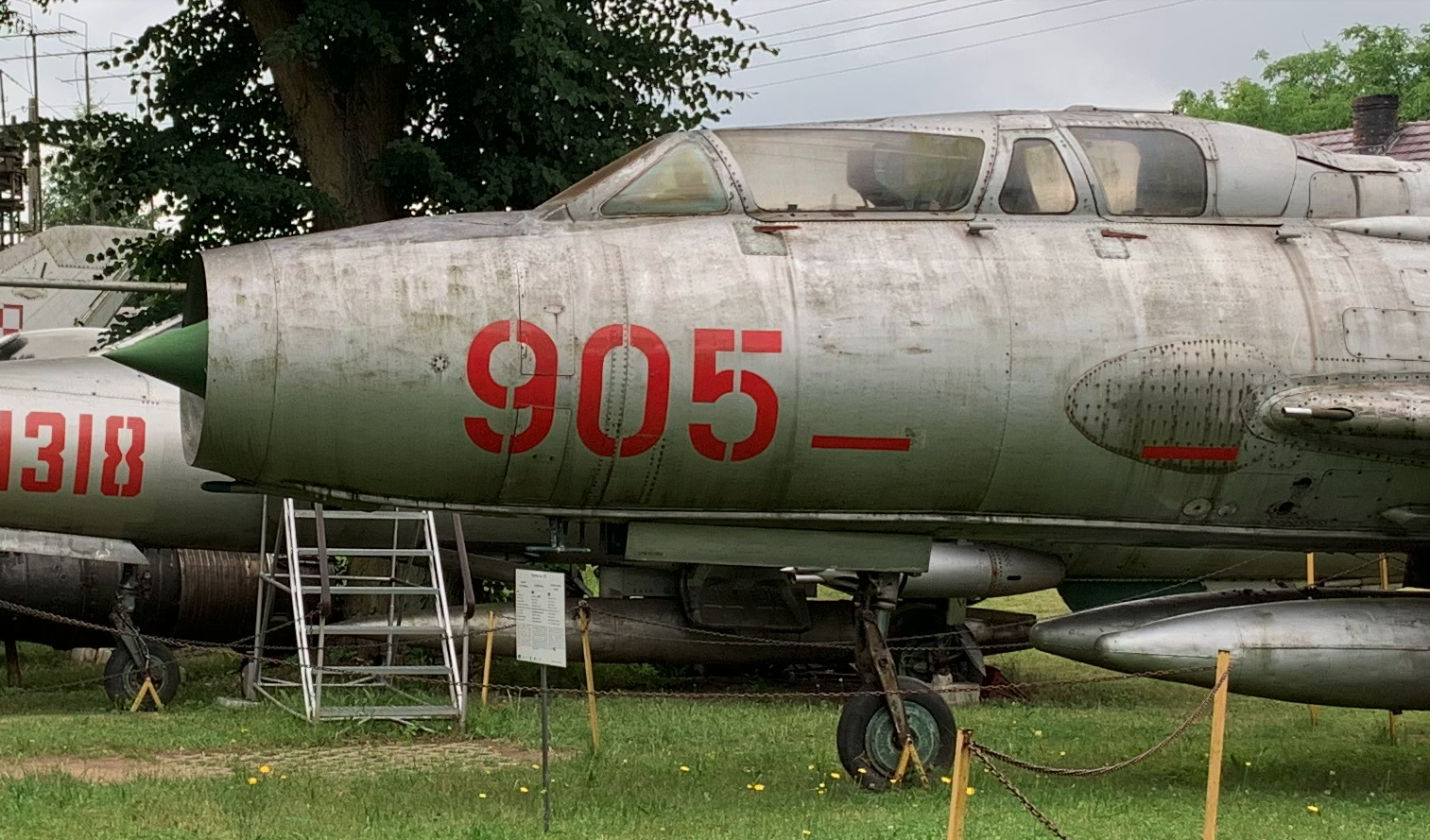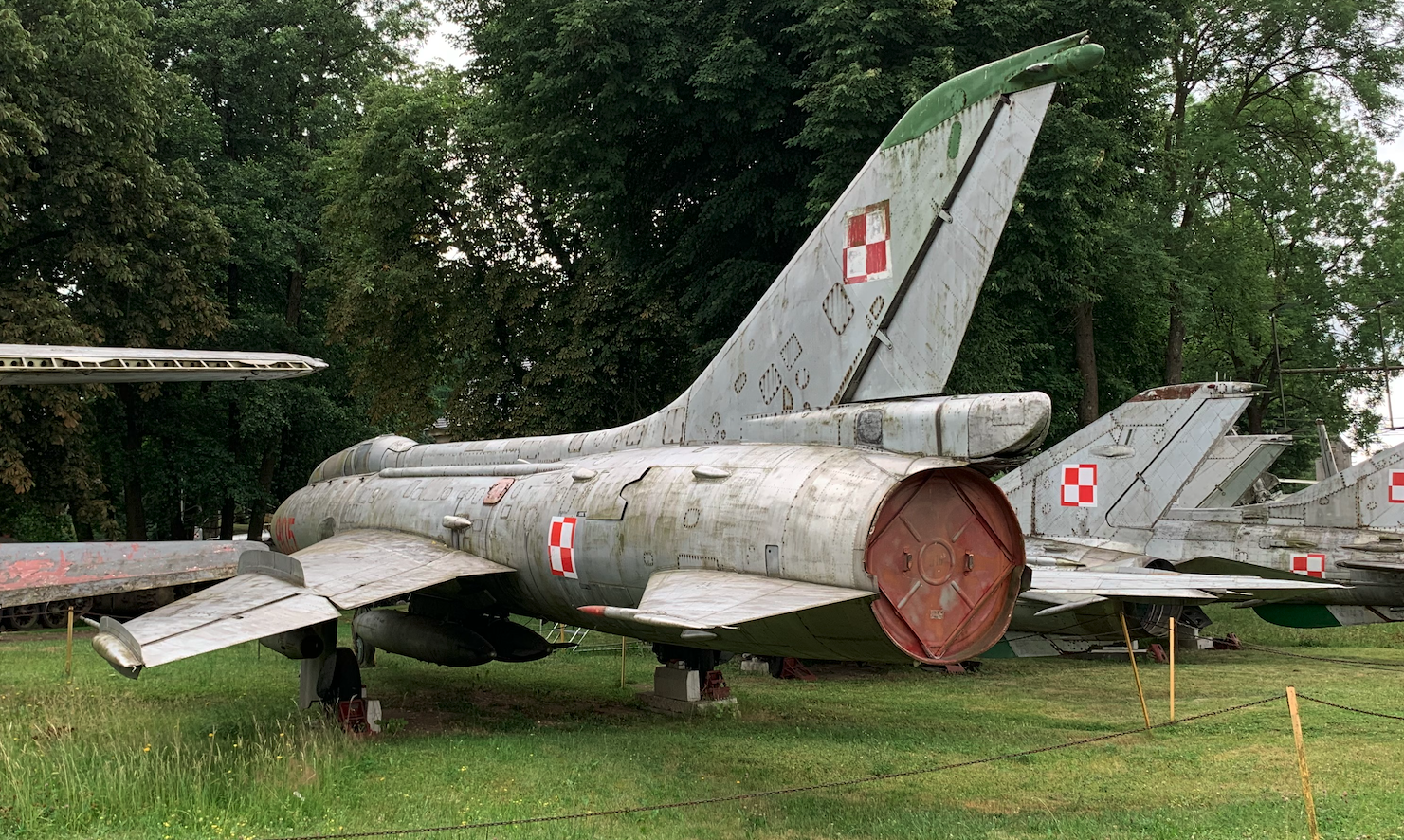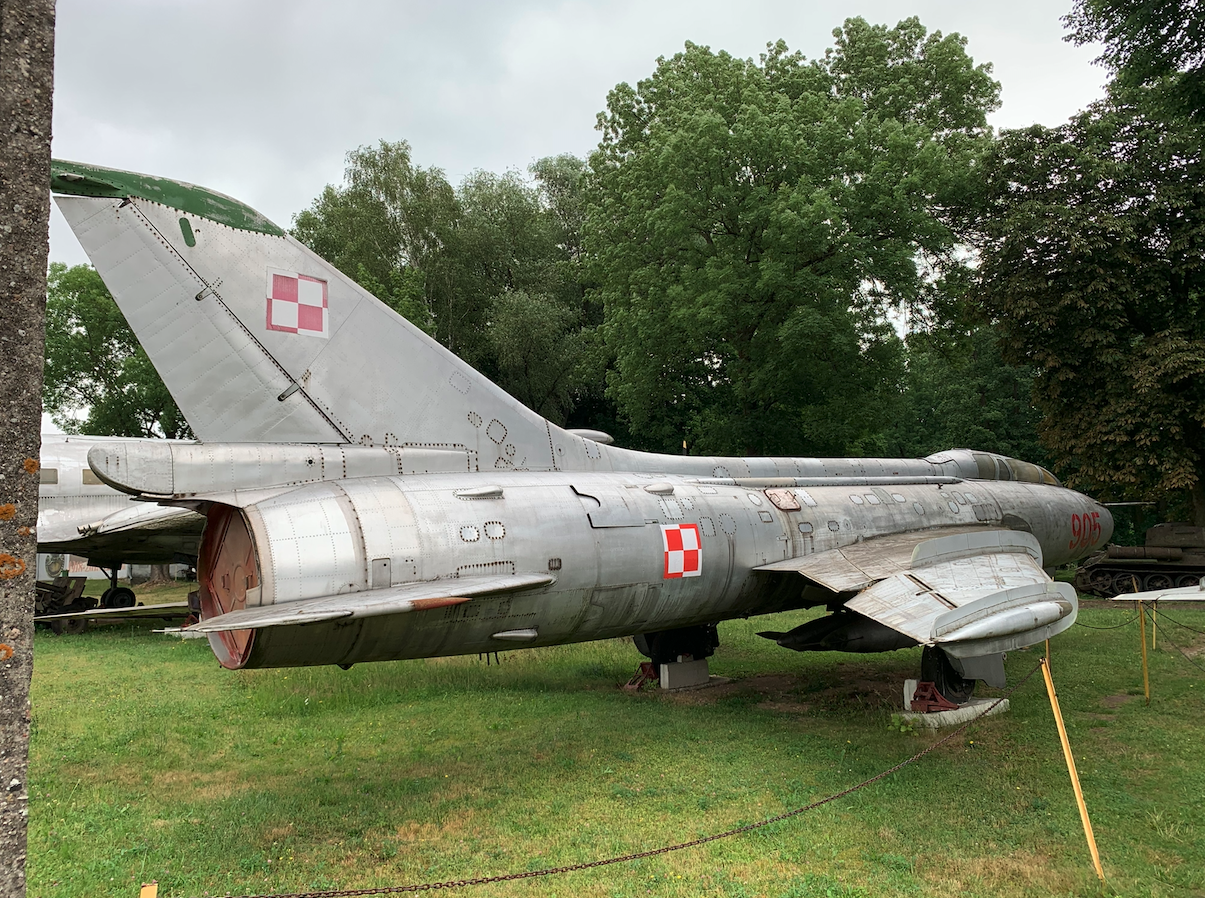Drzonów 2022-11-18
Suchoj Su-7 U nb 905 in the museum in Drzonów.
Soviet two-seat supersonic combat aircraft.
Su-7 B.
The real development of the Su-7 aircraft was brought about by the concept of atomization and rocketization of the battlefield, promoted by the Soviet military authorities in the 50s. The main role of carrying nuclear charges on the tactical battlefield was to be played by class z-z missiles and barrel artillery, however, in order to eliminate parts of the cells that were particularly mobile (columns of troops) or requiring precise strike (nuclear means of destruction of the enemy, secured command and communication stations), it was intended to be used as a carrier of a fast supersonic aircraft. Due to the high speed, large payload, powerful engine, adequate range and, equally important, the need to quickly introduce the machine to service (before the Su-7 B, provisionally modified MiG-15 /-17 aircraft were used for this role), the choice fell on the OKB design Sukhoi. The prototype of the fighter-bomber version was marked with the index S-22-1.
Su-7 U ( ros. Ucziebnoj ).
Due to problems with the first serial Su-7 aircraft, the development of a training and combat version was postponed. The lack of this aircraft caused a lot of problems in training young pilots for such a difficult aircraft as Sukhoi. Two training aircraft prototypes, designated U-22-1 and U-22-2, were built in the second half of 1965. The pilots were still waiting for this plane, so soon the machines underwent factory and then state tests, so that the first serial plane took to the air in April 1966. Its production was carried out until 1971.
The two-seater Su-7 U was based on the Su-7 BM aircraft. To install a second cabin in the fuselage, the front part of the fuselage had to be extended by 200 mm. In addition, the equipment so far behind the pilot’s seat has been moved to the upper fairing extending from the cockpit to the vertical stabilizer. The hull fuel tanks were also rebuilt, but their capacity did not change. The cabins had two covers opened pneumatically upwards.
The tandem arrangement of seats one behind the other on the same level, combined with large-size seats and equipment, prevented the instructor sitting in the back from having any visibility of what was happening in front of the plane. Of course, this was unacceptable, the cabin was equipped with two tilting mirrors made of well-polished metal. This worked by reflecting the image seen in the top piece of metal (on the top of the canopy at a working angle of 45 degrees) into the piece in the center of the cabin. So it was a typical periscope. The device had some limitations. It could not be used at speeds greater than 600 km/h. Simply the air resistance would destroy the top of the metal and its holder. One stroke of the instructor was enough and the upper element of the periscope assumed a safe angle of 0 degrees. After some time, the structure was strengthened, which allowed for flights at speeds of up to 850 km/h with an open periscope.
The crew received a special version of the KS-4U-22 ejection seats. The first pilot’s seat, and then the instructor’s seat, always fired, regardless of who initiated leaving the plane.
The chassis and its brakes have been strengthened. It should be remembered that at that time combat aircraft landed from a high descent to lose some of the energy on touchdown. The front leg of the landing gear was equipped with brakes and could be operated hydraulically. The chassis braking system received an installation spraying the wheel hubs with alcohol, causing their more effective cooling.
The increase in the weight of the entire aircraft caused limitations in the armament carried, the maximum lifting capacity was limited to 2,500 kg, some machines did not receive a left-wing 30 mm cannon. However, the possibility of carrying nuclear bombs was left. The sight used on the school aircraft is a modification of the Su-7 BM marked ASP-5ND-7U, replaced from the 12th production series with the newer ASP-PF-7U.
Su-7 UMK.
The export version of the training aircraft was distinguished primarily by a different type of radio station, a different IFF radar system. Unlike the Soviet prototype, it did not carry nuclear weapons. Its production took place in the period 1968 – 1970.
Su-7 in Poland. 1964 year.
The decision to adopt (purchase) the Su-7 B aircraft for Poland was made at the turn of 1962-1963, and Bydgoszcz and the 5th Fighter-Assault Aviation Regiment were chosen as their stationing place. The original contract was for 36 single-seaters and 6 training, two-seaters, which constituted a crew for one regiment with three squadrons. Our air force received its first 6 Su-7 BMs (53 series) a few months after Czechoslovakia, in June 1964. These were the only aircraft in the Su-7 BM version. We received the next 12 Su-7 BKŁ in 1966. All these planes were located in Bydgoszcz. The next deliveries are; 1968 – 2 Su-7 BKŁ, 1969. – 3 Su-7U, 1971. – 4 Su-7 BKŁ, 1 Su-7 U, 1972. – 12 Su-7 BKŁ, 1973. – 1 Su-7 U. In 1974-1977 – 4 Su-7 U (delivered together with Su-20 to Powidz). In 1986, these planes were transferred to the 3rd Fighter-Bomber Regiment (previously the 5th Fighter-Assault Aviation Regiment) in Bydgoszcz. In the second half of the 1960s, a group of pilots and technicians underwent special training in Soviet units in the CCCP. This training was related to the use of nuclear weapons. The pilots practiced the bombing technique from a low-altitude climbing flight. For this purpose, an imitation of a nuclear bomb was used. The tactical nuclear bomb (at that time called atomic) called 6U-57 was carried on the left node under the fuselage of the aircraft. The right subfuselage node carried an additional fuel tank. In the same way, additional fuel tanks were carried on nodes under the wings. With such tasks, the 3rd Pomeranian Fighter-Bomber Regiment lasted for many years. Only in February 1982, he was subordinated to the commander of the 3rd Brandenburg Fighter-Bomber Division. This was the result of the preparation of our aviation to accept more modern Su-22 aircraft, while leaving the Su-7 machines in operation. This happened on the basis of order No. 06/DWL of the Air Force Commander of February 23, 1982. For the 3rd PLM-B, the next change took place only in September 1988, when, due to the ending service life of the Su-7 aircraft, the regiment was renamed the 3rd Pomeranian Aviation Training and Combat Regiment. Su-7 aircraft, starting from the Su-7 BM version, were gradually withdrawn from service, and PZL TS-11 Iskra aircraft were introduced instead. In Poland, Su-7 aircraft were used until June 1990. As a result of the Helsinki Agreements on the reduction of combat assets capable of carrying nuclear weapons, the operation of the Polish Su-7s came to a definite end. Some of the planes were scrapped, but a significant number ended up in museums, mainly in 1994. On March 6, 1992, a ceremonial disbandment of the unit took place, during which the regiment’s banner was bid farewell. On April 30, 1992, the unit of the 3rd Pomeranian Training and Combat Aviation Regiment was disbanded. As a result of various events, 1 Su-7 BM aircraft (1970), 5 Su-7 BKŁ aircraft (1969, 1982, 2 x 1984, 1987) and 1 Su-7 U aircraft (from 7 BB-Rs) were lost in Powidz). It is worth noting that one Su-7 BKŁ nb 023 was handed over to the Czechoslovak Air Force in exchange for the plane accidentally shot down by the Polish MiG-21 PFM in 1971. In early 1988, the Soviets handed over one Su-7 BKŁ to Poland in exchange for the plane destroyed in 1987 by a Soviet pilot during a flight to a repair facility.
Suchoj Su-7 U nb 905.
The Su-7 U nb 905, No. 2905, was the 46th Su-7 aircraft delivered to Poland. He was admitted to the Polish Army in 1984. Production date: August 18, 1970. In 1970, delivered to the CCCP Air Force. On June 16, 1984, he was transferred to the Polish Air Force, to the 7th PLB-R Powidz. On March 24, 1986, he was transferred to the 3rd PLB Bydgoszcz. On February 4, 1990, the plane was donated to the museum in Drzonów.
Written by Karol Placha Hetman

